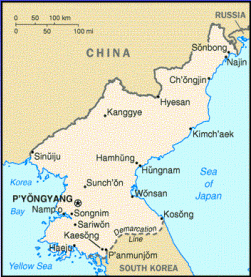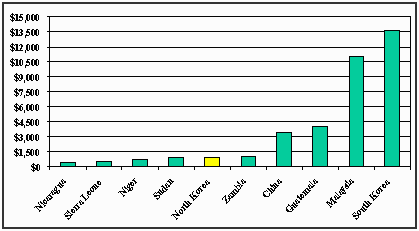Pitching in for North Korea's
Economic Development:
A WEFA Initiative
Institute for Corean-American Studies, Inc.
Spring Symposium
May 7, 1999
University of Pennsylvania
Robert West
Senior Vice President, International Relations

|
|
|
 |
 |
Slide 1
Slide 2
|
What we are NOT talking about
here:
|
- The NK missile program and armaments exports
- The Agreed Framework
- Famine
- War mongering
- The DMZ
- New government structure
|

|
|
|
 |
 |
Slide 3
|
Why stress economics?
|
- Whether the current regine survives or collapses, the economy of NK needs help from the outside to grow.
- After many years of "demonixation" of North Korea, a fresh attitude is needed.
- Planning, even when done centrally as in NK, requirea a statistical reporting system to determine where the economy is today, and some form of model for predicting how the economy will unfold in the future.
|
WEFA wants to pitch in.

|
|
|
 |
 |
Slide 4
Slide 5
Slide 6
Some successes, some failures
| SUCCESSES |
FAILURES
|
- The NK regime has provided education, health care, and education through first 11 years.
- Strong economic growth through the mid-1980s
- More open telephone service: US-NK, SK-NK
- More open approach to foreign trade
- Growing interest by foreign firms (GM, LG, Daewoo)
- Mechanization and irrigation have improved crop yields.
|
- Only 1 telephone per 750 people
- Heavy industry focus held NK back from achieving higher growth
- Food shortages in recent years have been severe
- Decisions are made at the top
- Poor infrastructure, both physical and informational
|
Many of the falures have resulted from central planning approach

|
|
|
 |
 |
Slide 7
North Korea's approach to economic development has been centralized, top-down, and inward-looking.
- Foreign trade - kept to a minimum, with imports still greater than exports.
- The barter economy is still large - unrecorded transactions, uncertain value.
- Whatever information is available on economic development is closely held.
- Self-sufficiency has been the watchword - although in the last 20 years, a more open attitude hbas emerged regarding foreign investment.
- the economy may have contracted by 30% since 1990.
|

|
|
|
 |
 |
Slide 8
Knowing the current economic conditions
in North Korea is very difficult.
There are no National
Income Accounts |
 |
Net Material Product
approach is taken |
Production is reported
only in index form |
 |
Time series are stopped when
they turn negative |
The service sector is
considered non-productive |
 |
Concept of industry clusters
may not be well understood |
No good price/inflation
data |
 |
Value of capital output & labor
inputs is difficult to measure |
Falling exports, focus
on heavy industry, lack
of transparency |
 |
Little/no foreign investment |

|
|
|
 |
 |
Slide 9
Slide 10
|
Economic Shock therapy is not the answer.
| What's needed for Shock Therapy to work? |
North Korea
| | Working infrastructure: transport, telecomm |
NO |
| Competitive experience or intuition |
NO |
| Civil law - regulations and controls |
NO |
| Currency-based economy |
NO |
| Willingness to open the borders to world trade |
NO |

|
|
|
 |
 |
Slide 11
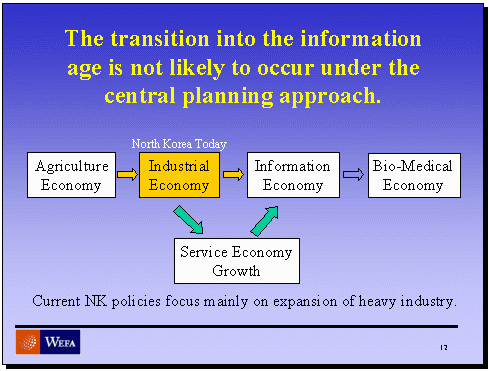
Slide 12
Slide 13
WEFA wants to help North Korea develop a new
economy based on the assumption that it is ready
to become integrated into the world economy.
• Over time, NK will have to implement several
key steps:
- introduce a common currency nationwide
for all transactions
- set up exchange rate mechanisms that
provide a semblance of free floating
- begin to measure and catalogue economic
activity using standard NIA accounting
• Define the industries that should be developed.
|
|

|
|
|
 |
 |
Slide 14
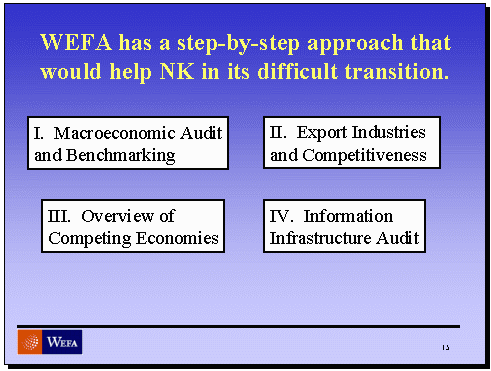
Slide 15
|
I. Macroeconomic Audit and Benchmarking
• Determine the strengths and weaknesses of the NK
economy
- Industrial policies and their effect on productivity
- Savings and investment (?)
- Barter versus currency, the role of exchange rates
- Lack of transparency
- Supervision of the financial sector
- Limits placed on Government activism
• Train NK staff in the workings of an open, free market.
• Highlights of key economic areas to address.
|
|

|
|
|
 |
 |
Slide 16
|
II. Export Industries and Competitiveness
• Examine market growth of NK's existing and
potential exports, produce forcasts.
• What is the competitive advantage that NK offers?
• Can industry clusters be developed around growth
industries that are export-focused? Tourism may
be a start.
• Can a long-term competitive footing be
|
|

|
|
|
 |
 |
Slide 17
|
III. Overview of Competing Economies
• What are the development lessons, both good
and bad, from other economies of similar size
and openness?
- Not many countries like this
- Paraguay, Kasakhstan, Cuba? South Korea
• How can NK use new technologies to leapfrog
to a higher stage of development?
- cellular telephones
- the Internet: market exposure, training, marketing
- production software and logistics management
|
|

|
|
|
 |
 |
Slide 18
|
IV. Information Infrastructure Audit
• What information is needed, and what is currently
lacking?
- industry outputs in physical terms is probably good
- information on prices and value of transactions is likely
to be absent
• What is feasible to collect?
- production may be easy, savings per capita may be difficult
- must develop a plan for data collection: by variable, by time
• Build an economic model for forecasting, performance
monitoring, and management
- investment, government spending, consumption
- otherwise forced to use benchmarking to track performance
|
|

|
|
|
 |
 |
Slide 19
|
What is needed for success?
- Clear and full committment from the NK government to move to a new form of economic magement.
- External support from the U.S., South Korea, Japan, etc., and the major multilaterals
|
- Understanding of the unique cultural and social practices
- Open access to relevent NK government officials
- Training of NK staff
- economics
- industry development
- 1 1/2 years
|
|

|
|
|
 |
 |
Slide 20
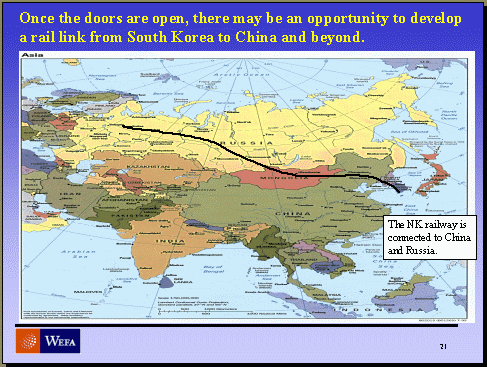
Slide 21
|
Potential Risks
- Inflation
- "Mafia - ization"
- Enforcement of laws and regulations
- Foreign "take over"
- State employees have a hard landing
- Some industries will have to close
|
|

|
|
|
 |
 |
Slide 22
|
Potential Results
- Economic databases and models with collection and updating routines established
- Development and training of NK staff in new methods of economic management and measurement
- Definition of industry clusters to be developed, the rationale, and the detailed business plans
- Attraction of foreign investors - tourism
- Open interaction with new trading partners
- Economic and personal income growth in NK
|
|

|
|
|
 |
 |
Slide 23
This page last updated 12/19/99 jdb
|




